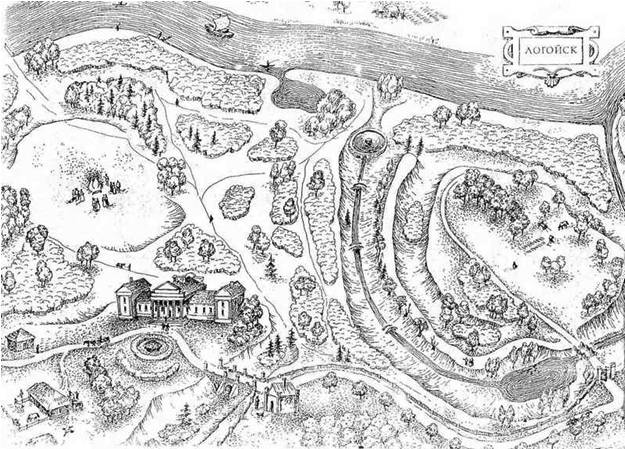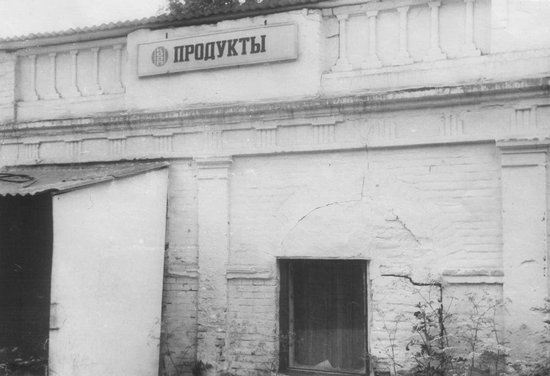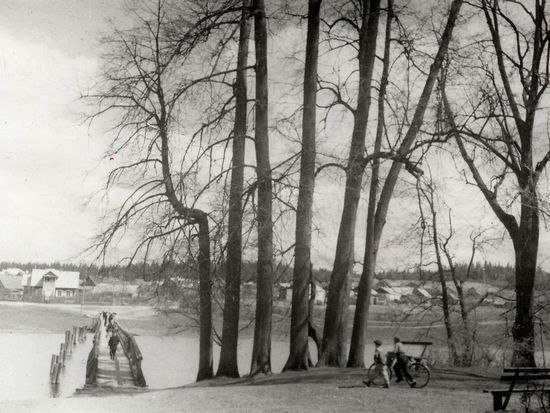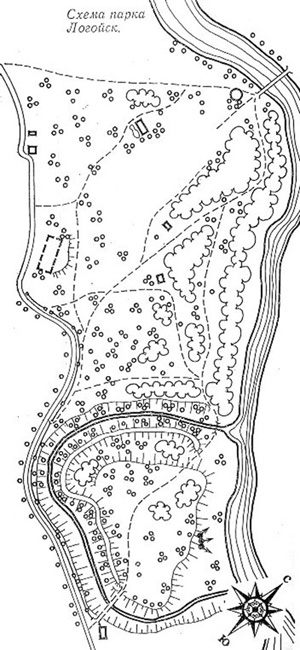The Tyszkiewicz Park in Logoysk
The park was founded along with the construction of the palace by Pius Tyszkiewicz from 1814 to 1819. Historical features of the territory existence of the castle during the Kievan Rus period (XI–XII cc.) contributed to the construction of the park. The park was located on a high (up to 25 meters above the floodplain) ground of the river Hayna and occupied an area of 1.5 hectares. The principles of the opening of the distant prospects for the river Hayna and the use of the remains of the former castle fortifications from a moat (in the past 4–5 meters depth, 16–18 meters width) were used as the basis for planning. They surrounded the courtyard in a semicircle.
The old hydrological system was disrupted long ago. Now, after reconstruction, water is pumped from the river Hayna into the moats and a fountain. A pond was created in the widest part of the former moat. A ground swell, covered with trees, remains one of the most expressive elements of the park; the trail with the views of the surroundings passes through it.
Trees growing on the swell slopes form a colorful scope of prospects. Views over the central part of the park with the ruins of the palace are seen from the northern part of the swell that has a form of a sharp ridge. A round pond with a fountain, which completes the castle moat, is located closer to the river. Earlier there was a water spring. On the other side of the swell there is a glade-hollow, formed in connection with the extension of the castle’s courtyard. Nowadays the glade has changed due to the planting of the Canadian, Maryland poplars tree and Ash-leaf Maple.

The former castle courtyard is rather large, it occupies the highest part of the terrace, which ends abruptly near a floodplain.
The crest of the terrace is cut down and strongly grasped by root systems of old trees. Below, the floodplain is always wet, overgrown with alder. The yard territory is cosy and due to the prospects it’s visually connected with Hayna and Logoysk. The accent of prospects was St. Nicholas Church (1824),and further on, on the hill, surrounded by old maples, Catholic Church of St. Casimir (The Tyszkiewicz burial-vault) was seen. The main facade of the building was oriented towards the park.
The park stretched for 700 meters along the right bank of the river Hayna. He had no clear composition, a narrow alley passed between parks and gardens. The alley had two gates with two entrance lodges. One of the gate lodges preserved till nowadays.

Towards the river the two-beam perspective was used as the basis for the park planning. One of them passed through the glade, which was surrounded by white poplars on one side and by fir-trees on the other that created a lighting effect. Two semi-circular groups of lime trees were located by the river Gayna, in the form of a horseshoe. Near the one there was an arbour.

The park territory between glades near the palace was slightly elevated. It was taken up by flower beds, and closer to the river-by the tract of trees. This is the most picturesque, well-preserved part of the park. A forest tract joined the plantations of young trees along the floodlands. There was a small pond. It had a decorative value, there was an arbour on its bank, and nearby was a small glass-factory.

Starting at the palace the walking route passed through the trees along the floodlands. Its direction was also connected with water springs, which formed the beauty of the park. No one knows how many there were of them; it is said that there were so many water springs as park paths. Springs filled with water ancient moats, the pond and the river Hayna. Their sound was heard all over the park, sources didn’t just babble, they sang. The spring water had medicinal qualities. The park is remarkable for its exclusive variety of plantings: about 300 names of trees and shrubs.
The most unique trees were: Large-leaved Linden (Tilia platyphyllosVitifolia), Small-leaved Gold Lime (Tilia cordata), Green Ash with creamy-white variegated leaves (Fraxinus Pennsylvanica Albomarginata ‘Variegata’).
